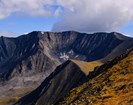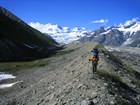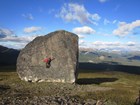Past glaciers have created a variety of landforms that we see in National Parks today.
-
Article 1: U-Shaped Valleys, Fjords, and Hanging Valleys

Glaciers carve a set of distinctive, steep-walled, flat-bottomed valleys. U-shaped valleys, fjords, and hanging valleys are examples of the kinds of valleys glaciers can erode. Read more
-
Article 2: Cirques

Cirques are bowl-shaped, amphitheater-like depressions that glaciers carve into mountains and valley sidewallsat high elevations. Read more
-
Article 3: Nunataks, Arêtes, and Horns

Nunataks, arêtes, and horns are the result of glacial erosion in areas where multiple glaciers flow in multiple directions. When the ice is present, they form stark, rocky outcrops above it, adding to the beauty of these harsh landscapes. Once the ice retreats, these uniquely-shaped features provide clear evidence of past glacier flow Read more
-
Article 4: Lateral and Medial Moraines

Lateral and medial moraines consist of glacially-transported rock and debris. They form on the sides of glaciers (lateral moraines) or at the boundary between two tributary glaciers (medial moraines). Either way, they often mark the edges of an ice body Read more
-
Article 5: Terminal and Recessional Moraines

Terminal and recessional moraines mark the farthest reaches of a glacier—its terminus—at a given point in time. They are usually built from rocks and debris that are transported to the glacier toe in the ice and melt out there Read more
-
Article 6: Glacial Till and Glacial Flour

The sediments produced through glacial grinding are very distinctive. Glacial till contains sediments of every size, from tiny particles smaller than a grain of sand to large boulders, all jumbled together. Glacial flour is that smallest size of sediment (much smaller than sand) and is responsible for the milky, colored water in the rivers, streams, and lakes that are fed by glaciers. Read more
-
Article 7: Glacial Erratics

Glaciers can pick up chunks of rocks and transport them over long distances. When they trop these rocks, they are often far from their origin—the outcrop or bedrock from which they were plucked. These rocks are known as glacial erratics. Read more
-
Article 8: Glacial Striations

As glaciers flow over land, they incorporate pieces of rock and sediment into the ice. These inclusions make the glacier sole (the bottom of the glacier) into a kind of coarse sandpaper that is capable of scratching bedrock. Over time, the glacier moves over rock and sediment, leaving striations or striae, on the rock surfaces that can reveal the direction that the glacier was flowing. Read more
-
Article 9: Paternoster Lakes

Paternoster lakes occur in a series down a formerly glaciated valley in small basins scooped out by the glacier as it retreated. Read more
-
Article 10: Kettles

As a glacier recedes, sediment is washed out from the glacier and deposited in a flat area below, forming an outwash plain. Depressions, known as kettles, often pockmark these outwash plains and other areas with glacial deposits. Read more
-
Article 11: Drumlins

Drumlins are hills of sediment (generally a quarter of a mile or more in length) that have been streamlined by glacier flow. Read more
-
Article 12: Outwash Plains and Eskers

Outwash plains and eskers form due to the flow of meltwater in front of (outwash plains) or beneath (eskers) that glacier ice. They are composed of glacial sediments that have been reworked by flowing water. Read more
